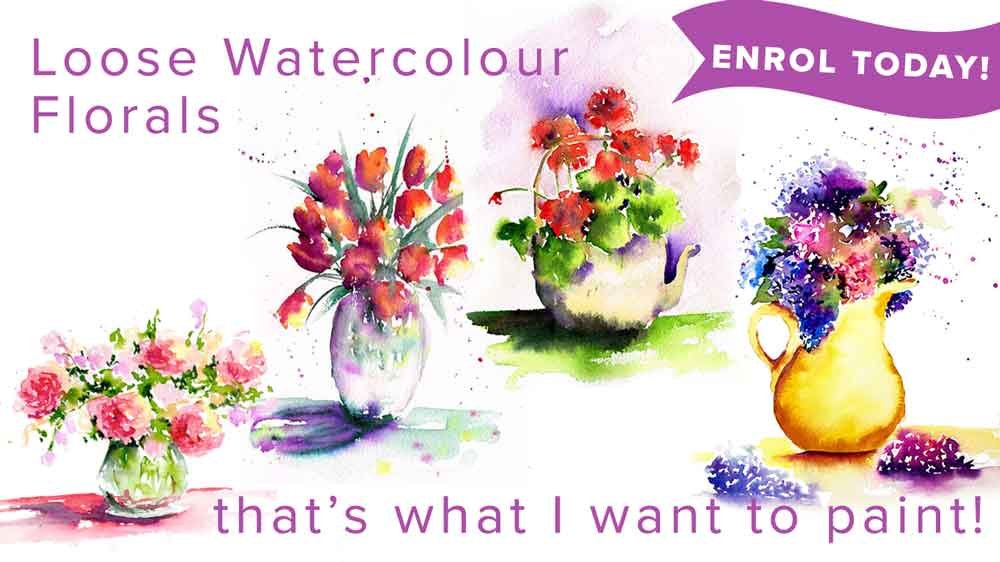Have you heard people talk of painting in a ‘loose’ style and wondered what that actually means?
Like a lot of things in art, it is rather subjective so perhaps the better question is to ask what loose watercolour painting means to you.
I think in coming to an understanding of what you want your own painting to look like, you really need to go back to your own reasons for painting.
I paint to relax, to remember the tiny delights in the everyday. Like when you walk into a room and out of the corner of your eye you catch a glimpse of a joyful vase of fresh flowers.
They can lift your spirits even before your eye takes in all their detail. They are a splash of fragrant colour and life in the room.
That’s what I want to paint.
Explore the Watercolour Tutorial Floral Bundle
I want to paint as effortlessly as possible, as effortlessly as the little flower blooms.
Does that sound lazy?
I think that when some people consider loose painting they think it is lazy painting. But to my mind a successful loose painting still needs strong bones. A good composition, strong values and a pleasing palette for example. Without these things the subject may not be recognisable.
There is certainly effort required for the painter to learn these things, so I don’t think a loose painting is lazy at all. It is more about an attitude of ease.
I want to paint with ease - with a glad heart and a confident brush.
That to me, is loose painting.
Another word that is often used is painterly, as in a ‘loose painterly style’. Broadly, both these words are describing a painting that is expressive - more about feeling than detail.
An alternative is a hyper realistic style where the painting is counted successful if it is almost an exact copy of a photograph.
Now why, I ask myself, would one want an exact painted copy of a photo…. Surely you could just use the photo itself? 🤔
For me part of the appeal of a painting is the evidence of the human hand and heart that created it. Personally, I like a painting to look like, well... a painting!
A painting like this is not just a facsimile of a subject, however pretty a subject it may be. There’s a story in the painting and the painter is always a part of that story whether they intend it or not.
That’s just a little bit magical, isn’t it?
I like the painting subject to be recognisable, but not in such minute detail as to be overworked. If it is a painting of flowers, I want it to look like flowers, but not like a botanical illustration out of a textbook.
It always seems to me that at some point, the strain of the painter’s exertion shows up in a tight painting. It becomes a story of the painter's efforts.
This rather diminishes the subject’s delight - probably the very reason the painter chose the subject in the first place. The energy and life of the painting is so often lost in the pursuit of illustrative detail.
Did you ever read the ‘Don't Sweat the Small Stuff' books by Richard Carlson?
Apart from being great advice on life in general from this happiness expert, this, I think, is the loose painter’s mantra.
How can you relax and enjoy painting the lovely parts of life when you are agonising over every tiny detail?
The basic approach I follow for painting in a loose style is the one that impressionist oil painters use.
Start with the big shapes, get those right and you are pretty much there.
For us watercolour artists most of that work is done in the drawing stage. Then, splash in the colour in the right values and you are almost done.
Watercolour collaborates with us when we paint and will add its own unpredictable but delightful variation. Every so often an expected run of colour will occur. It's probably a happy little accident as Bob Ross would say.
Let's embrace imperfection.
This is a part of your painting’s story, what makes your version of the subject unique, and much more than the photograph. We can of course keep adding details, and in fact, if we keep going we will end up with that hyperrealistic painting after all.
So the choice is yours… you get to decide when your painting has said what it wanted to say and that it is done.
There is a spectrum of looseness - you get to decide just how loose your painting will be.
Quite simply, loose painting makes me happy.
I hope it does the same for you.
I like to think that if I can learn, in painting, to let go of the small stuff and focus only on the big picture - what really matters, perhaps I will be learning to let go of the small stuff in life in general.
Yet another excellent reason to paint.
Want to join me?
Let’s paint 4 loose expressive florals together, step by step.
Are you on your own painting journey?
One of these might be useful…











